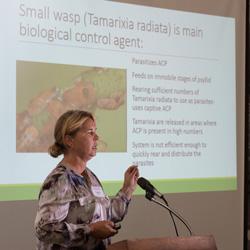Research on Display: Huntley College Hosts ARI Showcase

Can barn owls prevent gophers and voles from damaging vineyards?
Could a vaccine prevent chickens from dying of a respiratory disease?
Could a synthetic strand of DNA help food safety workers detect food-borne toxins more quickly and effectively?
Students and faculty from several California State University campuses presented their findings on these studies and many more at the 16th Annual CSU Agricultural Research Institute (ARI) Showcase. The Don B. Huntley College of Agriculture hosted the Nov. 3 event at AGRIscapes.
The ARI is an applied agricultural and environmental grant program to support research that leverages $4.3 million in annual state funding with university, industry, state and federal partnerships. Its peer-reviewed research projects address problems and challenges facing California farmers and consumers, such as improving food quality and safety, increasing productivity, reducing environmental impact and enhancing economic viability.
Students and faculty from Cal Poly Pomona, Fresno, Chico, San Luis Obispo, Humboldt and Monterey Bay participated in the showcase. A wide spectrum of departments was represented including biological sciences, plant science, animal and veterinary science, and human nutrition and food science.
View a Photo Gallery of the ARI Showcase
Researchers at Pomona presented updates on their long-standing research projects including biocontrol of the Asian Citrus Psyllid; breeding lettuce to use less water and nitrogen; testing whether using a liposome or tiny bubble of fat entrapping a vaccine could help chickens fight off a major respiratory pathogen called Aspergillus fumigatus, an infection that often requires the slaughter of large numbers of poultry; and using algae grown in dairy waste as a safe livestock feed.
Other Cal Poly Pomona projects explored:
- Whether a single strand of DNA or RNA could be used to quickly and accurately identify foodborne diseases compared to traditional means by detecting toxins produced by pathogens rather than targeting specific strains of microorganisms.
- Whether food scientists can use orange pomace, a waste byproduct, as an ingredient in extruded food products.
- The effectiveness of using the Southern California black walnut tree in landscaping and restoration.
- The feasibility of using juglone, an organic compound secreted by black walnut trees, as an organic, naturally-derived herbicide to control germination of native and invasive plants in Southern California.
- Whether food scientists can use membrane technology to purify natural colors from red cabbage.
San Luis Obispo students studied the flow of water from an aquifer system underlying Lower Scotts Creek in the community of Davenport, Calif., to wells and the fruit and flowering habits of mature “Wonderful” pomegranates.
Fresno State researchers studied whether an automated system could effectively detect nitrogen in the root zones of San Joaquin Valley agricultural fields. Excess nitrogen fertilizers or improper irrigation promotes leaching which is a common agricultural problem in all crops around the world.
A team of Chico State concrete industry management researchers explored how well rice straw fibers would work as ingredients in concrete. Another team examined whether they could raise half-blood Lowline-Angus steers with superior consistent growth and feed efficiency compared to commercial Angus steers.
Humboldt State students looked into the potential of using barn owls to control rodents in Napa Valley vineyards. Rodents can damage vines and roots, forcing vineyards to employ costly pest management practices. Another team explored converting forest byproducts into biochar, a charcoal that is used as an amendment to enhance soil properties.
Faculty and students either gave oral presentations to the audience or set up poster presentations for others to peruse during breaks in the showcase.
